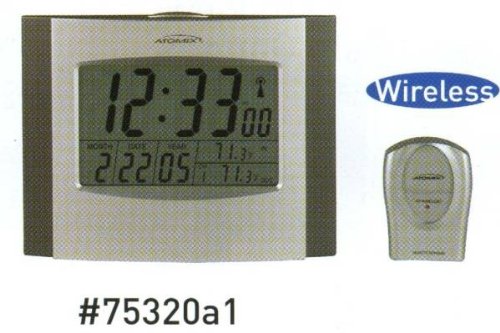All the basics are covered in this digital clock. Features include radio controlled clock technology, indoor and outdoor temperature, and calendar showing the month, date and year. This clock comes wil one remote temperature sensor.
Product Features
- Base unit measures 9 by 7 by 1-1/2 inches; sensor measures 3-1/2 by 2-1/2 by 1 inches
- Wireless atomic clock and thermometer with remote sensor
- Displays month, date and day; simultaneously displays indoor and outdoor temperature in Fahrenheit or Celsius
- Radio receiver picks up official Atomic Clock broadcasts
- Clock powered by three AA batteries; sensor powered by two AAA batteries






Overly complicated setup and Wireless temperature connectivity issues I purchased Chaney Instrument’s Atomix 75320 wall clock about eight months ago for our master bedroom bathroom. Setting up the clock and remote temperature sensor is much more complicated than need be and its remote temperature sensor is very problematic. On the plus side, the clock has large LCD numbers so they’re easy to read and the timekeeping is what you’d expect from a clock that syncs with an atomic clock.Following the directions to set up the clock work as expected but in my opinion getting the clock to “up and running” should be much easier given that the clock can receive atomic time (and the date?) from the NTIS. I would hope that putting batteries in the device, establishing the time zone and pressing the “get time” button on the top of the unit would be all the setup that is required. That is not the case. If you don’t pre-set the time, date, and time zone the unit never received the NTIS time at the established time of 1 or 2 AM (each times were listed on two different sets of documentation).The remote temperature unit has caused me the most grief. Chaney Instrument’s design requires user interaction to establish connectivity between the clock and remote temperature unit (RTU) but as long as you follow the setup directions establishing a partnership between the clock and RTU works. Still, when I put batteries in both the clock and then the RTU I would expect the two of them to automatically create a communication/connectivity “partnership”. However, after putting batteries in the RTU you must press and hold the TX button (TX = transmission) for three seconds. Unfortunately, TX button is under a four-screw battery cover so remember to do it before putting the cover back in place (if you’re not a person who likes to follow directions or who misses a step you’ll find yourself having to take the battery cover off more than you’ll care to).Unfortunately, I experienced an issue the second time I replaced the batteries, established a partnership and then moved the RTU to its mounting outside of our home. The RTU’s signal would no longer update the temperature display on the clock. Because the RTU is water resistant I mounted it up underneath the soffit which on our house is two stories above ground. In attempting to get the clock and RTU to “speak” I’ve climbed the ladder four or five times in order to get the RTU, descend the ladder, walk upstairs so I can see the clock, press and hold the clock’s channel button for three seconds to clear the partnership, unscrew the RTU’s four battery cover screws, press and hold the TX button to establish a partnership, tighten the four screws again, go downstairs, climb the ladder, and then slide the RTU back on it its mount. I feel like I’m training for some geek triathlon. 🙂 I’ve never gotten the clock and RTU to communicate when I put the RTU back on its mount so the clock says it’s always 73 degrees outside (and we don’t live in San Diego so that is definitely not the case).The support person said that the interference somehow occurred during the five minute interval between when the RTU was communicating with the clock and when I changed the batteries. Yeah, right.
Great concept, poor execution This clock would be excellent, but the numbers aren’t legible from some essential viewing angles. I don’t seem to have this problem with other digital clocks. Instead of this being the main kitchen clock on the wall as I intended, I’ve put this on top of the refrigerator as a spare.Update: Both myself and a relative have had the remote temperature unit fail within 1 month. Now I only get the indoor temperature displayed on the unit.
I never could get the remote to tell the base what the “other” temperature was. The base worked OK. Had to return the unit.
Comments are disabled for this post.